convert 2d drawing to 3d in solidworks
When creating 3D models for 3D printing, nosotros recommend taking the 3D printing process into account at all times. Smart modeling prevents 3D printing imperfections, weak areas, and minimizes the utilize of support material.
Some tips:
-
Adding small fillets to internal corners makes the printed part much stronger.
-
The minimum wall thickness for stereolithography (SLA) 3D press is 0.6 mm, for selective laser sintering (SLS) 3D printers it is 0.8 mm, and a proficient minimum fused deposition modeling (FDM) wall thickness is three times the nozzle size, typically iii x 0.four = one.2 mm.
-
Horizontal bridges or spans over 21 mm require support material in SLA 3D printing. FDM 3D printers tin can normally reproduce around 50 mm bridges without supports.
-
With SLA 3D printers, wires can exist very sparse, up to 20 times the wire width. For example, with 0.3 mm thickness, you can print upwards to vii mm tall before yous beginning to see waving. 1.five mm wires can get up to 30 mm tall without defects. Usable wires in SLS offset at 1 mm diameter and in FDM at four times the nozzle width.
-
For embossed details, stick to a minimum of 0.4 mm depth for SLA and SLS, and 0.6 mm for FDM.
-
For parts that are close together simply require a slight separation, stick to a minimum of 0.v mm clearance.
-
Keep overhangs to a minimum or at least below a certain threshold angle for 3D printing without supports. For SLA, the threshold is 19 degrees while for FDM, 45 degrees minimum needs to be attained. SLS 3D printers require no support cloth since the pulverization bed is self-supporting.
In our example, we are modeling a custom yacht model while keeping 3D printing restrictions in mind. This model entails some relevant features that need to be controlled to keep the model 3D printable, while offering advanced modeling challenges. 1 of these is the hull. Because of inner architecture requirements and hydrodynamics, a boat hull needs to be tightly controlled at several sections and is therefore created using a surface loft with multiple profile curves at unlike planes along the length of the send.
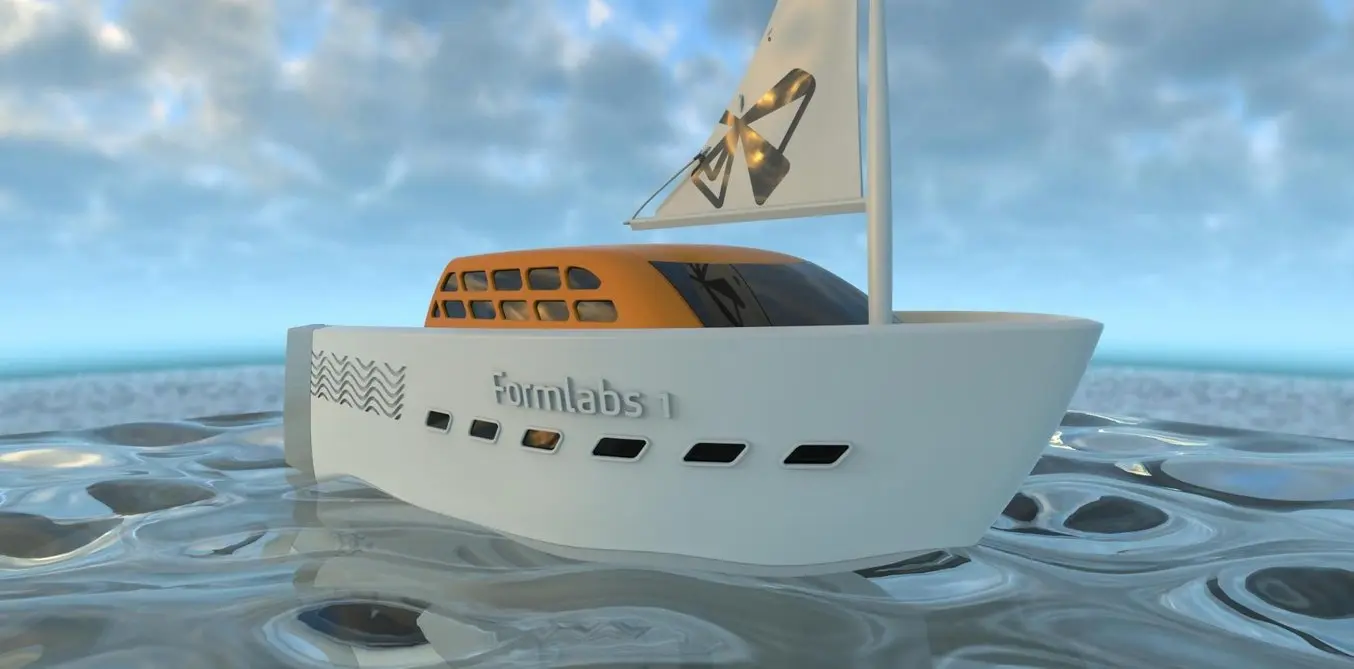
Our example custom yacht model creating modeled in Solidworks.
To create the topmost curve of the hull, we use the Projected Curve feature nether Insert → Curve → Projected and select the Sketch On Sketch method. This creates a three-dimensional combination of 2 different curves that are oriented on dissimilar planes. For the hull, an outline of the boat shape drawn from the top was projected onto an upward sloping curve drawn from the side.
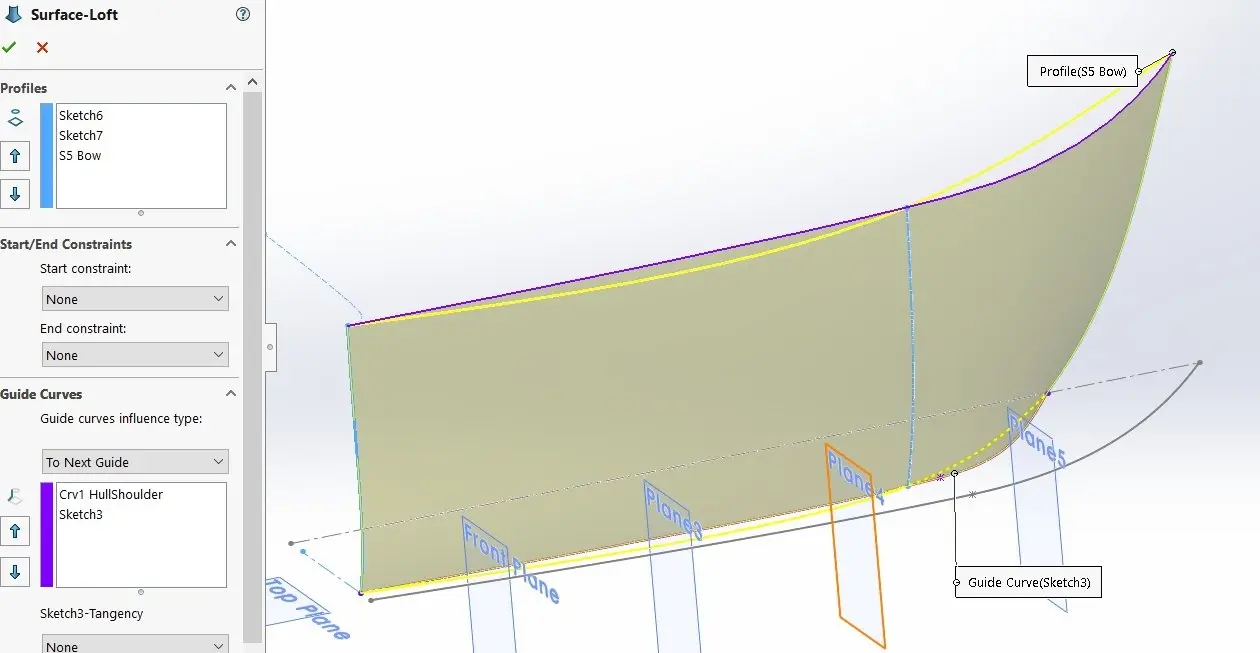
Lofting enables creating shine surfaces through multiple profile curves.
This lofting operation uses strictly defined curves at all sides plus profile curves. Using this many curves has to be done carefully because it will impact surface curvature. Another mode to create surfaces is to create a loft between 2 curves only. Keeping things simple frequently results in amend quality surfaces, which in turn leads to more robust and high-quality models.
To control the lofting direction, use either one guide curve or Start/Stop Constraints which tin can be set in the Loft menu. When using a guide curve, the two profile curves are typically fatigued on planes that are created perpendicular to the guide curve at its endpoints. When opting for Tangency or Curvature start and end constraints, employ an extruded or ruled surface to define the lofting management. Setting the first and end Tangent Length and then allows precise control. Using this method, intersections between different surfaces will be less defined and take to be created afterwards using trims or separate lines, merely the advantage is superior surface continuity.
A sweep operation is similar in function to a loft but uses one contour curve. A boundary surface is even more similar to a loft with the difference that it allows setting start/end tangency in both directions. The advantage is more command but at the cost of overall surface curvature.
Lofting Pro Tip #one: To evaluate surface quality, check Curvature Combs and/or Zebra Stripes under Curvature Display at the lesser of the surface functioning menu.
Lofting Pro Tip #ii: In the 3D viewport, right-click and choose Show All Connectors. This allows the user more command over how dissimilar curves are continued, preventing undesired occurrences such equally torsions.

Lofting surfaces freely in infinite results in bully surface continuity.
With the gross surfacing work completed, it is fourth dimension to combine them together into volumes. In our yacht model, every side of both the hull and cabin superstructure has been created as a separate surface. Now when choosing Insert → Surface → Trim Surface, select the Mutual choice and cull the surfaces to exist combined. Then SolidWorks allows creating the parts of every surface to maintain or delete, and automatically stitching the remaining parts together into one single surface body.
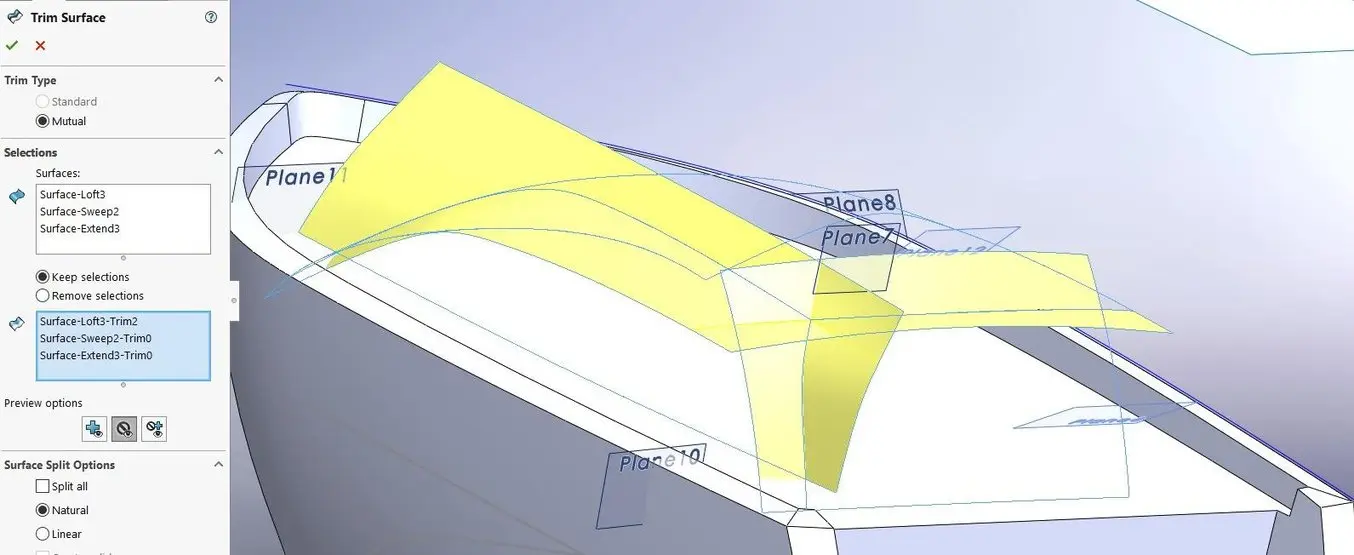
Trimming different lofted and swept surfaces together into a unmarried volume.

All major surfaces have been created using lofting/sweeping then trimming operations.
Creating an edge at an angle or perpendicular to the original surface is a pop blueprint feature. The Ruled Surface feature nether Insert → Surface → Ruled Surface allows that and offers the Tapered to Vector choice. This allows picking a reference edge equally the management vector and specifying an angle at which the ruled surface will be generated in relation to the reference vector. In the yacht model, both the edge providing thickness to the summit of the hull and the edge moving downwards to connect with the deck were created using a ruled surface. An alternative to the ruled surface is Radiate (Insert → Surface → Radiate). This creates an border perpendicular to the base of operations surface following an edge or split up line on that surface.

The Ruled Surface operation offers several options to create flanges.
Adding fillets to a 3D printable model is recommended considering they make the function stronger and less decumbent to crack forming. Additionally, they besides catch the light and add to the aesthetic impression.
There are many ways to add fillets to a design:
-
Edge Fillet: Circular
-
Border Fillet: Conic Rho
-
Border Fillet: Conic Radius
-
Edge Fillet: Curvature Continuous
-
Variable Radius Fillet
-
Face Fillet
-
Full Circular Fillet
-
Hold Line Fillet / Blend
A Round Fillet is the well-nigh basic, too computationally speaking. Over five mm in size it will result in a visible line on manufactured items as an optical effect where the surface meets the fillet—for 3D printing the maximum radius is slightly college because the surface roughness hides imperfect surface continuities. The advantage of using Edge Fillets is that every fillet can be simultaneously practical to multiple edges, whereas other fillet types accept to be individually created for every edge.
Conic Fillets have get increasingly popular amidst CAD designers as the next best thing because they effect in a smooth blend while being computationally lightweight. The Conic Rho parameter here allows setting the 'peakiness' of the fillet.
Curvature Continuous Fillets are the most computationally intensive simply result in the highest quality.
A Variable Radius Fillet allows transitions in radius within the aforementioned fillet. This comes in handy when the fillet ends in a tight cusp where a very low or zero radius fillet works and other types of fillets fail.
A Face Fillet creates a rounding between specified faces rather than edges–in some cases this results in a more robust fillet functioning. Checking the option Constant Width sometimes creates better results.
The Full Round Fillet is a specific type of confront fillet that creates a full round rounding between 3 faces such every bit the crosscut side of a thin solid. When modifying the geometry, the full round fillet automatically scales along.
A Concord Line Fillet is a variation of the confront fillet where not but the radius is specified, but also the lines where the surfaces involved meet the fillet. This only works on solid bodies and the use of separate lines typically results in successful hold line fillets. In instance the surface is difficult to catechumen to a solid first for creating the concord line fillet, an alternative approach is cutting the surface open with trim lines, then blending the open up sections together using a Loft performance and using Insert → Surface → Knit to combine all surfaces back into a single surface trunk.

Use Concord Line Fillets to create big blends between surfaces.
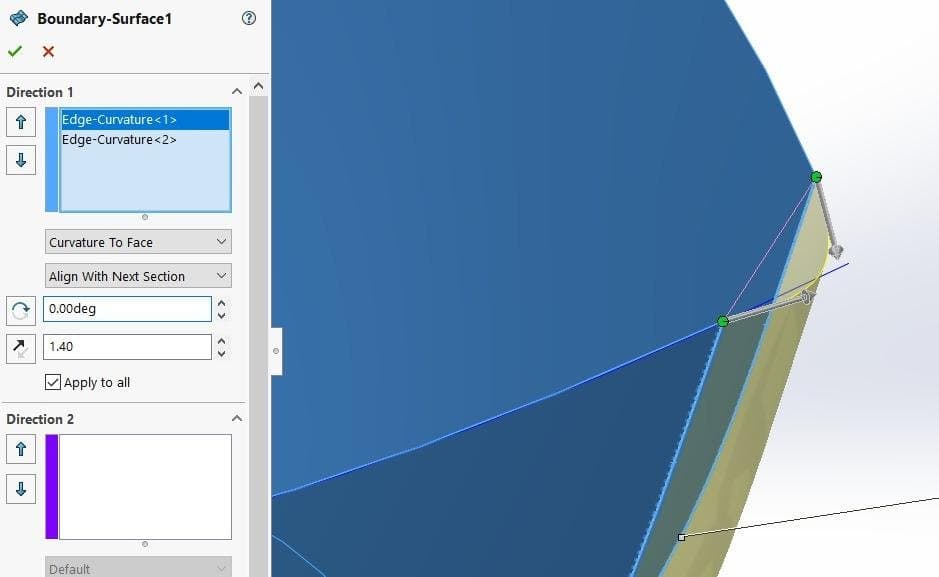
The bow front was filleted with a surfacing feature to optimize curvature.
It is preferable for 3D printing to create thin-walled models, because these also ascertain the inside of the model instead of leaving information technology up to slicer software to create infill and wall thicknesses. When modelers have attained a complete surface model, information technology is necessary to convert these into solid bodies. Ornamental details such as fillets and embossing are added afterwards since these may impede the solidification process.
At that place are multiple workflows to go about converting surfaces to solids:
-
Knit to Solid: When all surfaces connect to enclose a book, cull Insert → Surface → Knit Surface, then check Create Solid.
-
Thicken: Choose Insert → Boss/Base → Thicken, bank check Create Solid from Enclosed Book to generate a airtight solid body, uncheck it for a thin trounce.
-
Trim to Solid: When all mutually trimmed surfaces result in an enclosed volume, these tin be immediately converted to a solid past ticking the box Create Solid.
-
Offset: Create an offset surface that represents the inner wall with Insert → Surface → Beginning. Then information technology is possible to connect the edges using the Loft command. At present, instead of selecting a single edge, select the entire edge boundary loops by right-clicking on the container box in the menu under Profiles and choosing SelectionManager. Make sure to take the showtime points of both edge loops at an side by side position and y'all will be able to loft the unabridged connection in ane swoop. With the inner surface and connecting edges selected, they tin now exist converted to a solid with a Knit to Solid process. An alternative to lofting is creating a ruled surface at an angle so information technology intersects the inner surface, and then using the Trim to Solid approach.
-
Shell: After having created a solid from an enclosed surface volume, sparse walls can be achieved with Insert → Features → Shell. This starts an advanced script that creates a hollow solid part ready for 3D press.
For our 3D printed yacht, the deck including the superstructure is printed equally a split up part from the hull. This is a logical separation considering both parts have a apartment surface that will largely print without any support material. Where surfaces include but big fillets without small details, the Thicken operation works well.
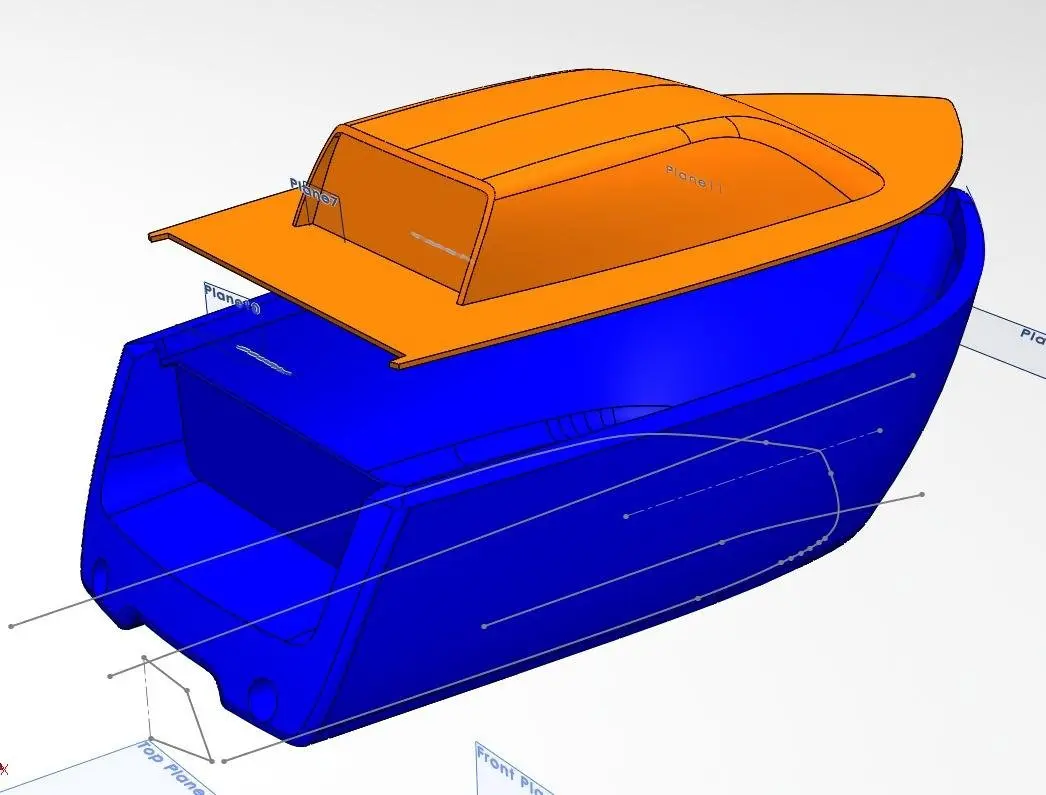
Surface bodies are turned into thin-walled solids with the Thicken control.
In several cases, designers and engineers want to create separate solid bodies, for instance when applying different wall thicknesses to unlike parts of the model. To merge solids with each other, SolidWorks offers Boolean operations under Insert → Features → Combine. To unify multiple parts into one, choose Add together. Subtract will cut out one shape from the other, while Common leaves but the function where multiple bodies overlap.
In Assembly Manner, it is likewise possible to combine carve up parts with the Bring together feature. Get-go, create a new function with Insert → Component → New Role, then click Insert → Features → Join. This volition unify selected parts inside the assembly at their electric current position and orientation into one single body.
The best style to divide a solid body into 2 sections is by using the Carve up command under Insert → Features → Split. Showtime, create the cutting surface—it can have whatsoever shape and can fifty-fifty exist a sketch. Then hitting Cut Part and decide in the Resulting Bodies panel which ones to keep. In example of requiring simply ane function to exist retained, an culling is the Cutting with Surface command under Insert → Cutting → With Surface.
Pro Tip: Salvage out an individual body of the design equally a separate SolidWorks .SLDPRT file with Insert → Features → Save Bodies. To keep a reference to the original part so that the design will be automatically updated in sync with the original model, create a Derived Part by right-clicking the torso in the FeatureManager and select Insert into New Role.
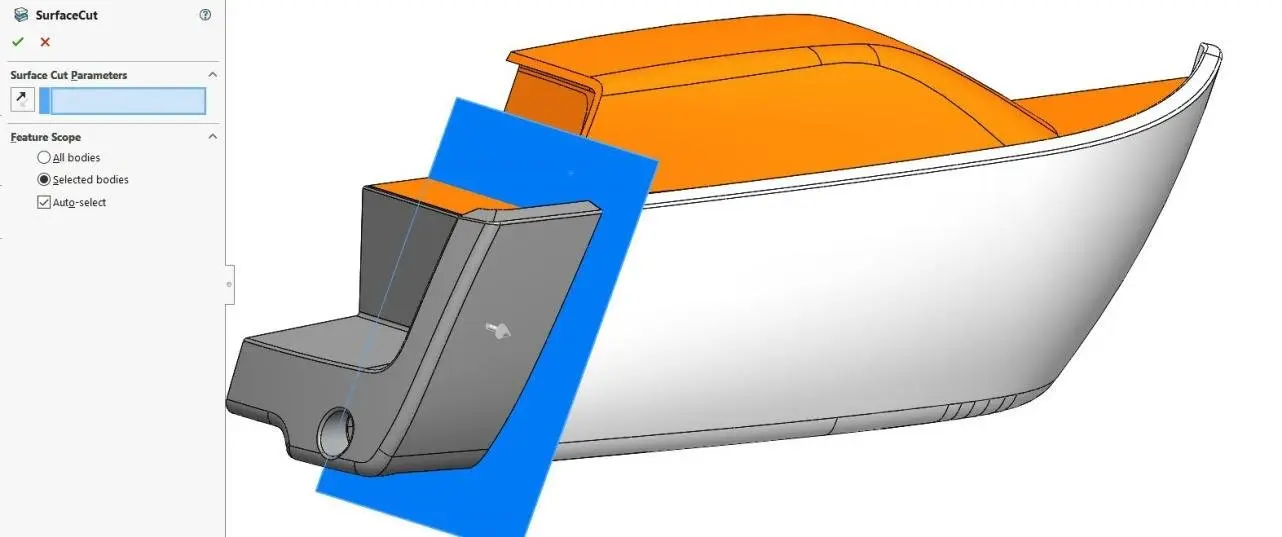
A cut surface divides the model into two divide solids.
For parts of the model that are spaced apart, exit at least 0.5 mm clearance to ensure they exercise not fuse together during 3D printing. When 3D printing multiple parts that demand to be fitted together, such as the hull and deck in our project, it is important to adhere to good tolerancing practices. For a snug fit, get out 0.25 mm clearance for parts created with FDM, and 0.15 mm for SLS, and SLA.
Offsets are the go-to way for creating distances between related features. Besides offsetting surfaces (Insert → Surface → Offset) information technology is too possible to create a sketch equally an offset from an existing sketch or edge. To get-go a sketch, open up a new sketch, select the original one, and click on Offset Entities. For offsetting only a office of the original sketch, or offsetting edges in the model, first import these to your sketch with Convert Entities. With the imported entities selected check Construction Geometry to indicate that these are not the sketches to exist used for the feature just an in-between footstep. At present select the parts to offset and hit Offset Entities.
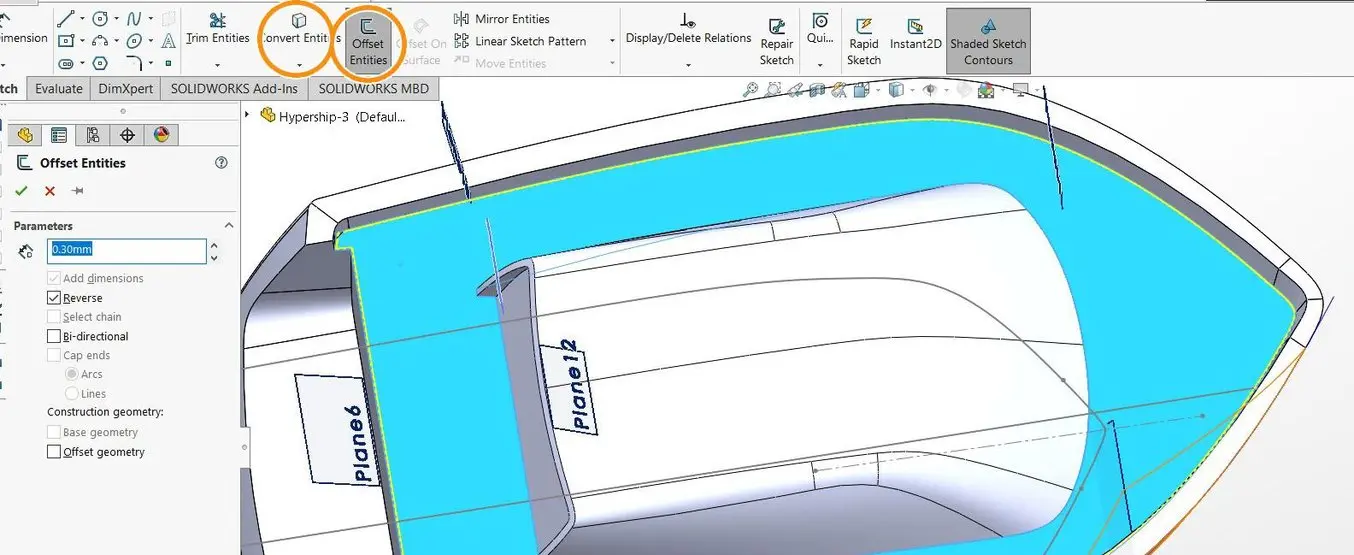
Utilize Get-go features for creating clearances between different 3D printed parts.
Offsets are also good for negative clearances, that is when features need to overlap. Consider for example the case of adding ribs to the inner hull. Ribs are an accessible method to add strength to the function at specific locations. For any curved surface, we cannot merely draw a bend on the surface and extrude it to create a rib, considering information technology would not connect to the original surface in all places. To ensure a consequent overlap, we need to showtime it into the solid body just enough so the extrusion will overlap on all sides. An offset curve can be created at a section aeroplane to the original surface, then using the Intersect option under Insert → Curve → Split Line and selecting the department plane and surface. Now create a new sketch on the section plane and offset the carve up line to create the offset curve. Finally, draw the entire feature then information technology can be extruded.

A negative get-go creates overlapping features that can exist merged into a single part.
SolidWorks provides aplenty opportunities for adding three-dimensional text features to a blueprint. Most font types volition be readily convertible into SolidWorks, with a preference for Sans Serifs. Lettering tin can exist added to a sketch using Tools → Sketch Entities → Text. Text tin can exist mapped to follow a curve, it can be mirrored, and individual messages can be rotated under a specified angle.
A specific method applies to mapping text onto curved surfaces: text wrapping. This repositions text drawn on a planar surface onto a curved, preferably cylindrical, ane. In order to approximate the hull'south shape, draw an arc sketch on the tiptop plane best matching the curvature of the hull, then extrude the sketch. Create the text feature on a plane or planar surface facing the curved extrusion. At present wrap information technology onto the cylindrical surface with Insert → Features → Wrap. The text is now scribed onto the surface and divides it into unlike faces. If nosotros delete the faces surrounding the letters likewise as the openings (known as 'eyes' in typography), only the letters remain. These will then be individually converted into a solid using the Thicken command and positioned onto the hull with Insert → Features → Motility/Copy.
Now with an offset of the hull surface and the Cut with Surface control as mentioned in the section Working with Multiple Solids, the text can be cut so its outer surface exactly follows that of the hull. The reason why we did not option the more than advanced Spline Surface wrap method is that using a cylindrical wrap maintains the horizontal orientation of the text where otherwise it would be oriented downwards along the hull's normal vectors. Note that when wrapping directly onto a solid torso, it is possible to immediately emboss or deboss the text into the solid.
Pro Tip: Use a maximum sideways protrusion of 1 mm for lettering for support-free 3D printing. The minimum legible detail for SLA 3D printing is 0.1 mm for embossing and 0.iv mm for engraving, 0.35 mm for SLS, and 0.6 mm for FDM.

The wrap role offers advanced ways of adding text to surfaces.
The preferred way of creating grooves on a solid body is the Sweep performance under Insert → Cutting → Sweep. Every sweep needs a guide curve and profile curve. A guide bend on a planar surface can be directly sketched onto that surface, simply for a curved surface, we need to create a projected bend or split line. The option Round Profile merely creates a tube along the guide bend. With the option Solid Profile, it is possible to choice a solid body to generate the cut and emulate a CNC cutting tool. With a custom Sketch Contour, it is possible to install an additional twist value, so the cease of the swept groove will be at a different specified angle than the kickoff.
In our example, we have swept a foursquare over a sinusoidal split line on the boat hull. The foursquare is positioned at a 45-degree angle relative to the guide bend in lodge to enable printing without stark overhangs. For an exact design, every split line will accept to be provided with its own sweep. For the small cut off elements at the edge of the patterning area, information technology is adequate in some cases to copy and interpret the nearest swept solid torso, and cut it with the bend that divers the original patterning expanse using the Cutting with Surface command.
Pro Tip: The sinusoidal curve was created by choosing Equation Driven Curve nether splines in the sketch tab. This allows designers to input XY functions that direct generate a spline. For an advanced option, it is possible in SolidWorks to set a prepare of variables and drive these using Excel worksheets.
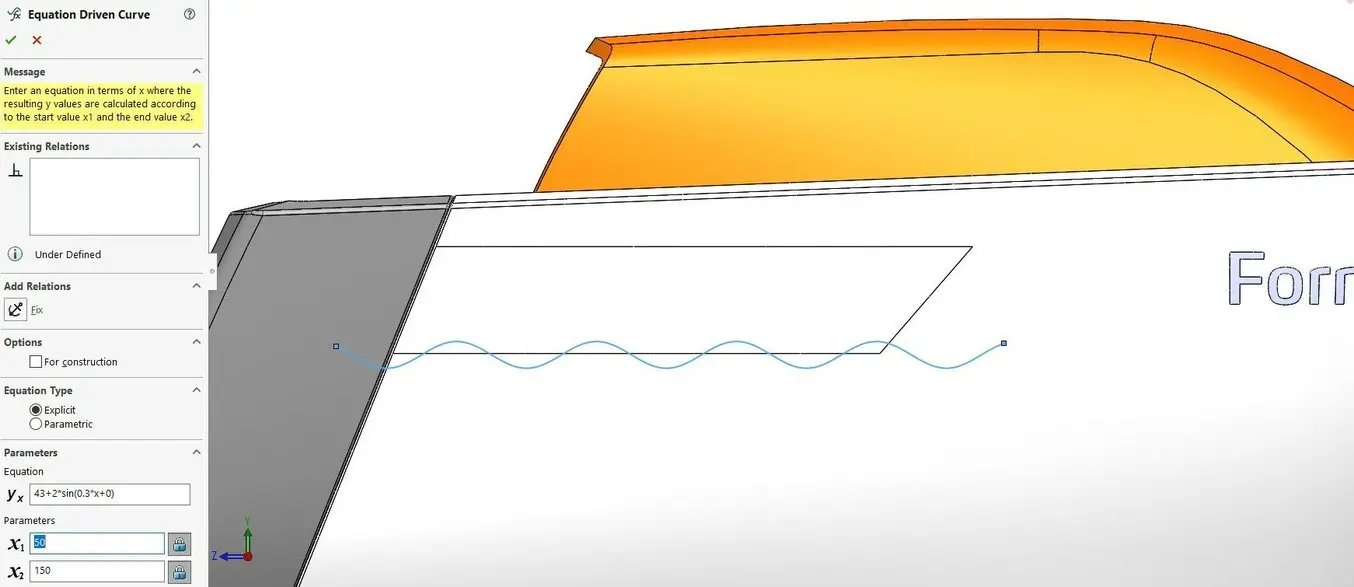
Use Equation Driven Bend for mathematically defined sketches.
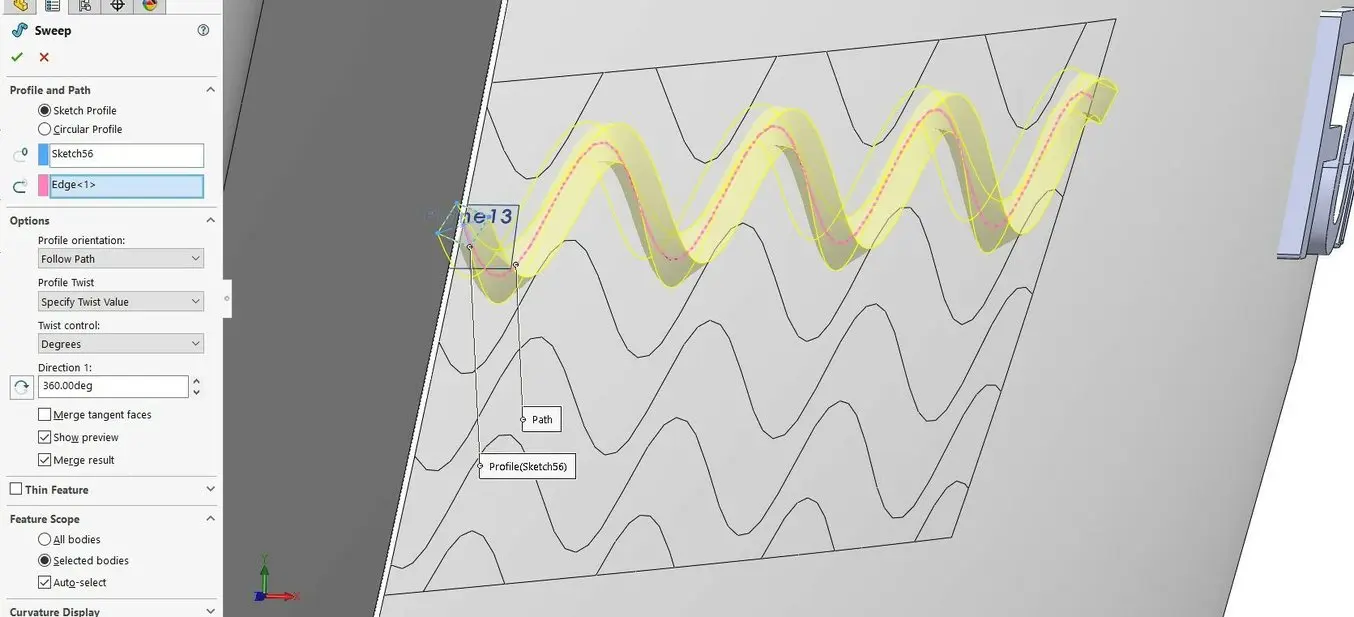
Twisted sinusoidal sweeps making for a iii-dimensional graphic surface area on the hull.
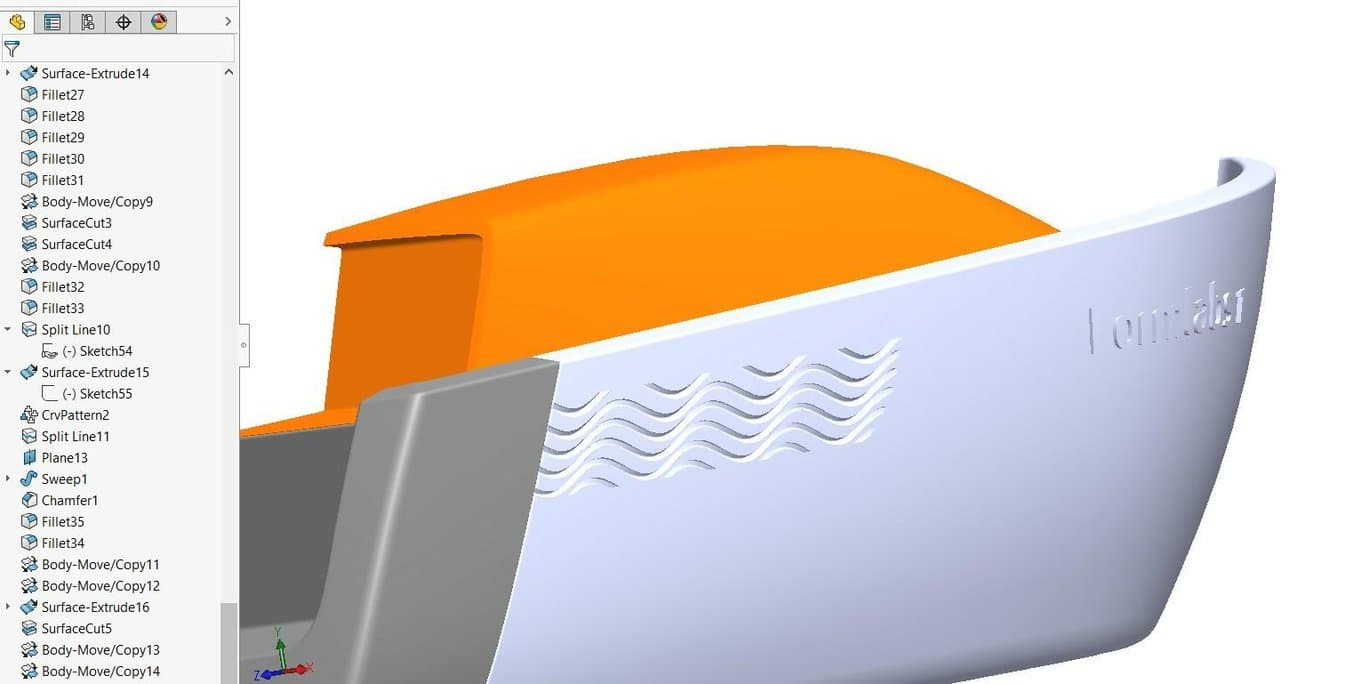
Designing patterns manually can be a flake ho-hum. In SolidWorks, information technology could not be simpler creating a linear or rotational pattern of an object or characteristic with the Insert → Design/Mirror → Linear Pattern and Insert → Pattern/Mirror → Circular Blueprint commands. It is also possible to provide a numerical linear translation or rotation when using the Insert → Features → Motion/Copy command and ticking the Copy box with the number of copies called.
If we project a curve onto a solid body as a Split Line, we can pattern some other solid body such as a window along that bend, even maintaining the normal direction to correctly orient every example on the curve. To exercise that, cull Insert → Pattern/Mirror → Curve-Driven Design and tick the radio box for the Tangent to Curve alignment method. If spacings need to be uneven, it is possible to define the locations using points in a dissever sketch and opting for a Sketch-Driven Blueprint nether Insert → Pattern/Mirror → Sketch-Driven Pattern. Going beyond that, it is even possible to generate point locations inside a sketch past linking a mathematics-driven Microsoft Excel canvass or from a text file containing the coordinates using the Insert → Design/Mirror → Table-Driven Blueprint operation. This type of parametric control enables designers to generate the geometrically complex and organic features that 3D press excels at.
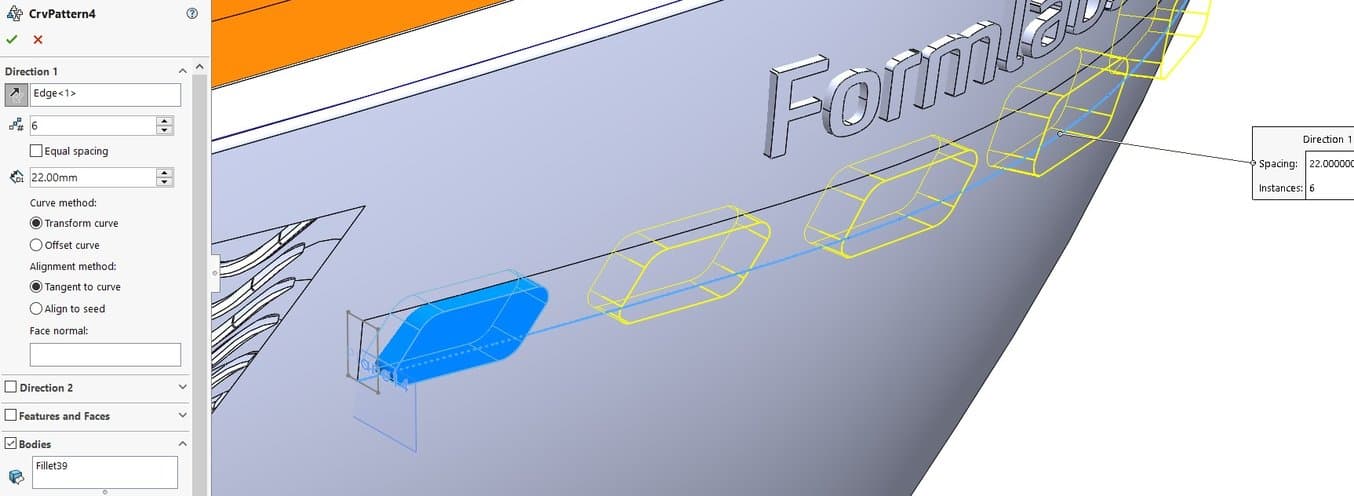
Curve-driven patterns work to create repeated elements on a circuitous shape.
Another nice feature is the Fill Pattern, attainable under Insert → Pattern/Mirror → Fill Blueprint. The offset pace is to define an surface area to be filled with patterned elements. Side by side, choose a patterning layout and spacing dimensions. This is an automated way to create graphically interesting perforations for parts like speakers, air vents, and showerheads. Further customization is possible by selecting the Instances to Skip at the lesser of the Fill up Pattern menu.
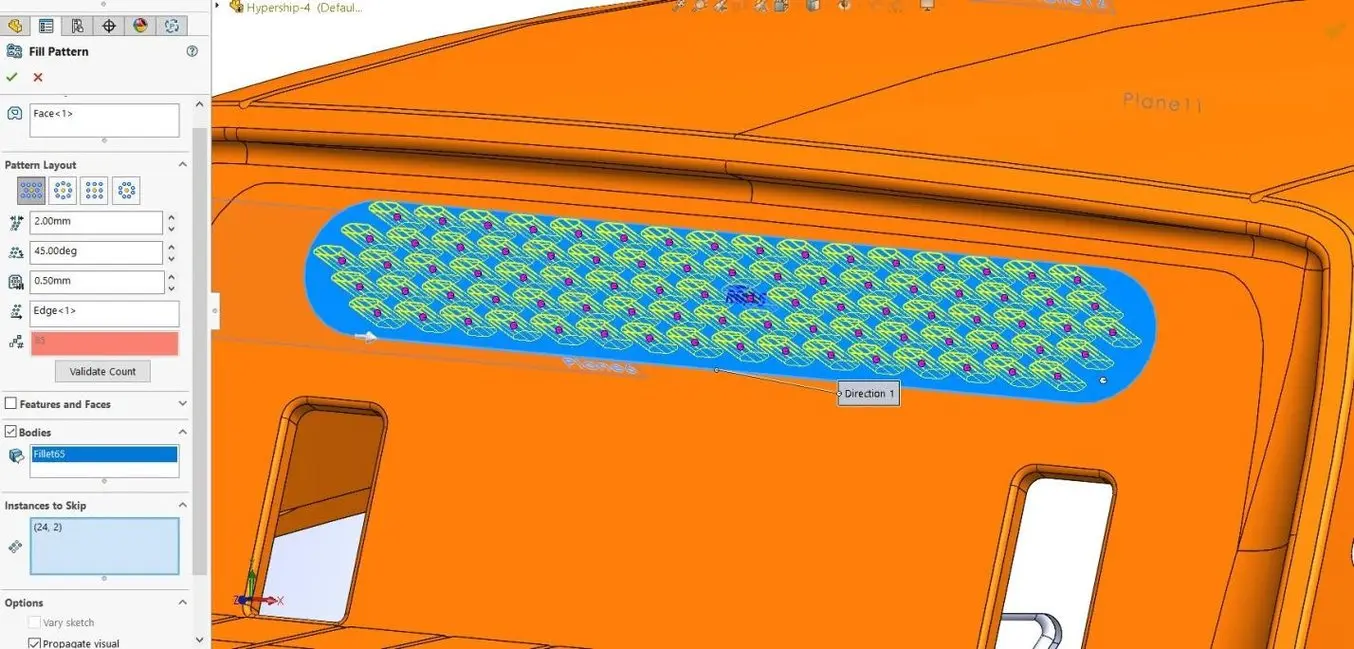
Make full Design automatically generates graphically interesting perforations.
The Flex feature is an odd one out in SolidWorks because it is not driven by sketches, and notwithstanding, it results in workable geometry that cannot be generated otherwise. Accessing information technology nether Insert → Features → Flex enables the designer to curve, twist, taper, and stretch solid and surface bodies after they accept been modeled. These features likewise stack up successively for increasingly circuitous surfaces. Boosted control on the center pivot location of the twist, taper, or bend can exist accomplished using a control triad. This requires creating a Coordinate Organization reference outset past clicking Insert → Reference Geometry → Coordinate System. The triad can be relocated by selecting an element to movement it to in the 3D viewport, then hitting the right mouse push on the center of the triad, then Move to Option. Moving the Trim Planes and then allows bending only a specific portion of the model.
Another mail-surfacing functioning is Freeform (Insert → Features → Freeform), where the designer tin add command points on section curves across a complex surface. These points, equally well equally the start and stop curvature direction of the department curves, can so be individually modified allowing organic and unusual surface shapes to be fabricated.
Deform, nether Insert → Features → Deform, will morph a shape from a reference point or surface, in a detail direction and with a specific elasticity (the Stiffness option). The Curve to Curve mode accurately transforms one curve inside the part to a newly created bend so the function gains an entirely new shape. In Surface Push manner, a separate surface is used as a stamp that nearly deforms the part by pressing into it.

Flex is a post-processing performance to bend, twist, and taper bodies similar this propeller.
Source: https://formlabs.com/blog/solidworks-tutorial-3d-printing-modeling-inspection/
0 Response to "convert 2d drawing to 3d in solidworks"
Postar um comentário